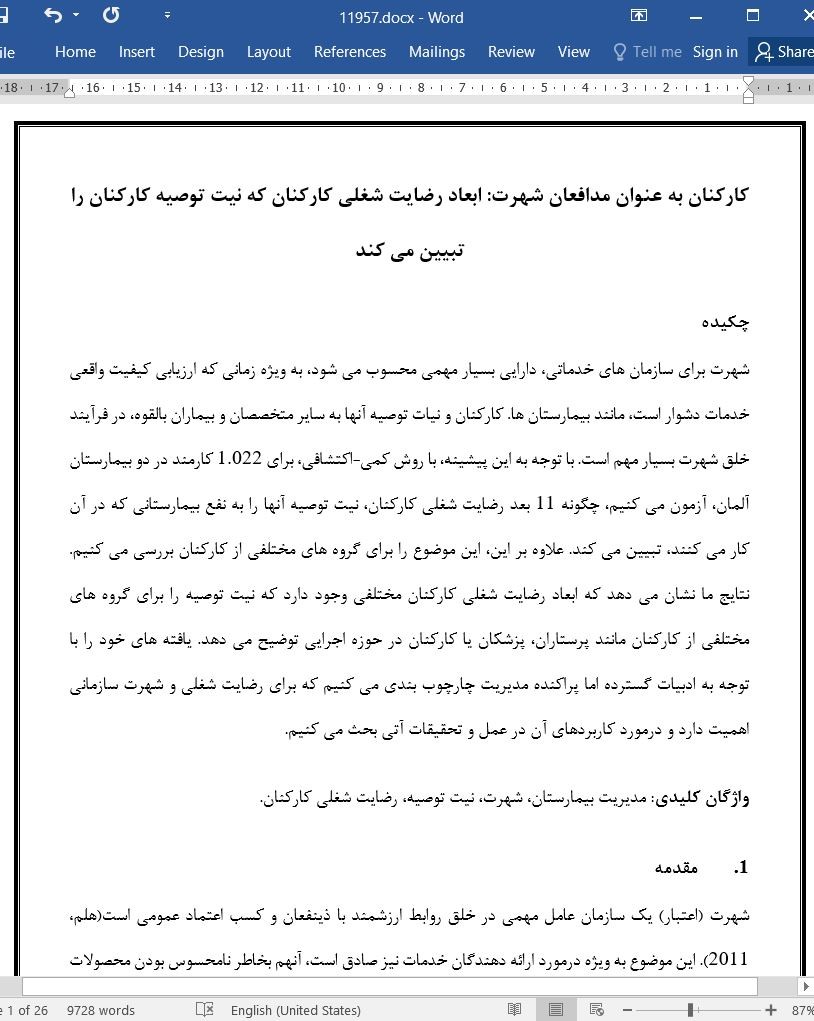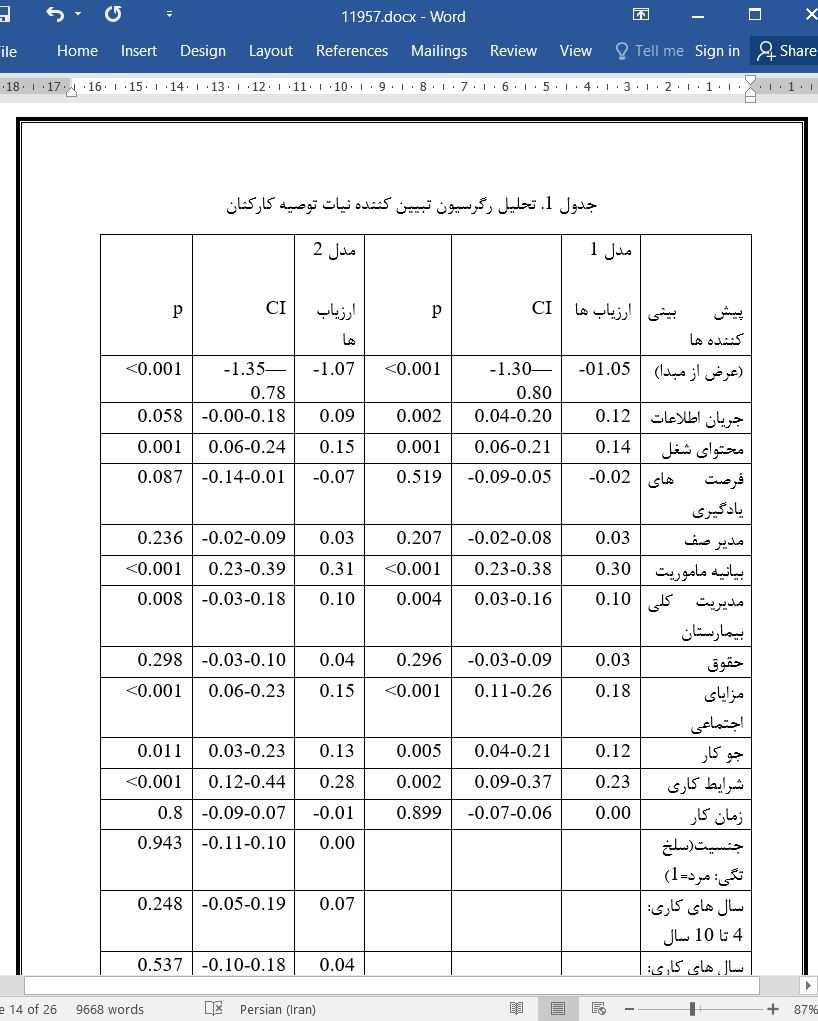
ابعاد رضایت شغلی کارکنان که نیت توصیه کارکنان را تبیین می کند
چکیده
شهرت برای سازمان های خدماتی، دارایی بسیار مهمی محسوب می شود، به ویژه زمانی که ارزیابی کیفیت واقعی خدمات دشوار است، مانند بیمارستان ها. کارکنان و نیات توصیه آنها به سایر متخصصان و بیماران بالقوه، در فرآیند خلق شهرت بسیار مهم است. با توجه به این پیشینه، با روش کمی-اکتشافی، برای 1.022 کارمند در دو بیمارستان آلمان، آزمون می کنیم، چگونه 11 بعد رضایت شغلی کارکنان، نیت توصیه آنها را به نفع بیمارستانی که در آن کار می کنند، تبیین می کند. علاوه بر این، این موضوع را برای گروه های مختلفی از کارکنان بررسی می کنیم. نتایج ما نشان می دهد که ابعاد رضایت شغلی کارکنان مختلفی وجود دارد که نیت توصیه را برای گروه های مختلفی از کارکنان مانند پرستاران، پزشکان یا کارکنان در حوزه اجرایی توضیح می دهد. یافته های خود را با توجه به ادبیات گسترده اما پراکنده مدیریت چارچوب بندی می کنیم که برای رضایت شغلی و شهرت سازمانی اهمیت دارد و درمورد کاربردهای آن در عمل و تحقیقات آتی بحث می کنیم.
1. مقدمه
شهرت (اعتبار) یک سازمان عامل مهمی در خلق روابط ارزشمند با ذینفعان و کسب اعتماد عمومی است(هلم، 2011). این موضوع به ویژه درمورد ارائه دهندگان خدمات نیز صادق است، آنهم بخاطر نامحسوس بودن محصولات آنها، که ارزیابی کیفیت آنها را مبهم و ناتمام ساخته است(سیو، سوانسون، چینچاناکوکچای، هاسیو و چن، 2016؛ وانگ، لو و هایو، 2003). شهرت مطلوب و قوی، از ابتدا ریسک انتخاب یک ارائه دهنده خدمات ناتوان و ناکامل را کاهش می دهد. در نتیجه، یک شهرت قابل اطمینان برای بقای هر ارائه دهنده خدمات ضروری است.
گرچه، تحقیقات زیادی درباره اینکه چگونه مشتریان بر شهرت سازمانی تاثیر می گذارند وجود دارد، تحقیق برای بررسی نقش ضروری که سایر ذینفعان- به خصوص کارکنان- در مدیریت شهرت ایفا می کند، آغاز شده است(هلم، 2011؛ لاگز، 2012؛ شاما و حسن، 2009). از آنجا که کارکنان به عنوان ارائه دهندگان خدمات محسوب می شوند و راجع به کارفرمایان خود اطلاع رسانی می کنند، تبدیل به حامیانی برای شهرت سازمان شده اند(هلم، 2011). مطابق منطق تئوری ذینفع و تئوری وابستگی منابع، کارکنان منابع حیاتی سازمانی – شهرت سازمان- را بوسیله نیت خود برای پیشنهاد و توصیه یک سازمان به کارکنان و مشتریان بالقوه- کنترل می کنند. ادبیات شواهدی ارائه می دهد که این رفتار با رضایت شغلی کارکنان ارتباط دارد(لاگز، 2012). با این وجود، تحقیقی وجود ندارد که به بررسی رابطه بین رضایت شغلی کارکنان در سازمان های خدماتی و رابطه آن با نیات توصیه کارکنان بپردازد. از این رو، مطالعه ما بر رضایت شغلی کارکنان و رابطه آن با نیات توصیه آنها به عنوان یک رفتار فعال خلق شهرت توسط کارکنان تمرکز دارد.
Abstract
Reputation is a crucial asset for service organizations, in particular when actual service quality is hard to assess, e.g. in the context of hospitals. Employees and their recommendation intentions to other professionals and potential patients are crucial in the reputation building process. Against this background, we test with a quantitative-exploratory approach, for 1,022 employees in two German hospitals, how eleven dimensions of employees’ job satisfaction explain their recommendation intention on behalf of the hospital they work. Moreover, we explore this for different employee groups. Our results show that there are different employee job satisfaction dimensions explaining recommendation intention for different employee groups such as nurses, doctors, or employees in the administrative field. We frame our findings against the broad but scattered management literature that is relevant for job satisfaction and organizational reputation, and discuss implications for practice and further research.
1. Introduction
An organizations’ reputation is an important factor in creating valuable stakeholder relationships and gaining public trust (Helm, 2011). This is particularly true for service providers, as the intangibility of their offerings makes the assessment of their quality vague and incomplete (Su, Swanson, Chinchanachokchai, Hsu, & Chen, 2016; Wang, Lo, & Hui, 2003). A strong and favourable reputation reduces, ab initio, consumers’ risk of choosing an incompetent or incapable service provider. Consequently, a solid reputation is essential for the survival of any service provider.
While there is extant research on how customers influence an organization’s reputation, research to explore the crucial role other stakeholders – especially employees – play in reputation management has begun (Helm, 2011; Lages, 2012; Shamma & Hassan, 2009). Because employees act as service providers and communicate about their employer, they become advocates for the organization’s reputation (Helm, 2011). Following the rationale of stakeholder theory and resource dependence theory, employees control a vital organizational resource – the organization’s reputation – by their intention to recommend an organization to potential employees and clients. Literature provides evidence that this behaviour is related to employee job satisfaction (Lages, 2012). However, there has been no research, as yet that examines the relationship between employee job satisfaction in service organizations and its relatedness with employees’ recommendation intentions. Hence, our study focusses on employees’ job satisfaction and its relationship with their recommendation intention as an active act of reputation building by employees.
چکیده
1. مقدمه
2. پیشینه: رفتار خلق شهرت، نیات توصیه و رضایت کارکنان
2.1. رفتار خلق شهرت و نیات توصیه کارکنان
2.2. رضایت شغلی کارکنان و رابطه آن با نیات توصیه کارکنان
2.3. تفاوت های بین گروه های کارکنان
3. روش تحقیق
3.1. نمونه
3.2. معیارها
3.3. روش تحلیل
4. نتایج
4.1. مرحله 1. اندازه گیری مولفه ها و آمارهای توصیفی
4.2. مرحله 2: تحلیل رگرسیون و تسلط
5. بحث و رهنمودهایی برای تحقیقات آتی
6. محدودیت ها و تحقیقات آتی
7. کاربردهای عملی
منابع
Abstract
1. Introduction
2. Background: Reputation building behaviour, recommendation intentions, and employee satisfaction
2.1. Reputation building behaviour and employees’ recommendation intentions
2.2. Employee job satisfaction and its relationship with employees’ recommendation intentions
2.3. Differences between employee groups
3. Research method
3.1. Sample
3.2. Measures
3.3. The method of analysis
4. Results
4.1. Step 1: Measurement of constructs and descriptive statistics
4.2. Step 2: Regression and dominance analysis
5. Discussion and avenues for future research
6. Limitations and further research
7. Practical implications
Declaration of Competing Interest
Acknowledgements
Funding
References
- اصل مقاله انگلیسی با فرمت ورد (word) با قابلیت ویرایش
- ترجمه فارسی مقاله با فرمت ورد (word) با قابلیت ویرایش، بدون آرم سایت ای ترجمه
- ترجمه فارسی مقاله با فرمت pdf، بدون آرم سایت ای ترجمه



